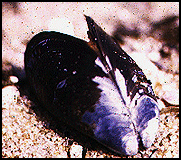 | ||||||
| Articles | Projects | Resume | Cartoons | Windsurfing | Paintings | Album |
The Effects of Pulp Mill Effluent on
Byssal Thread Production by the
Marine Blue Mussel Mytilus edulis

by Waterose

Section 5. Recommendations for Future Study:
The statistical analysis could not be completed on the data results for two reasons. Firstly, there was inadequate data obtained from trial 1 so a duplicate result was not obtained. Secondly, it was not possible to obtain a true mean of byssal thread regeneration because the regenerated threads from individual organisms were intertwined in each group in the solution container. It is recommended that for any future trials that the organism replicates be individually contained in the solution. Furthermore, it is recommended to incorporate the individual organism mass:thread regeneration ratio which could be a factor that relates to the amount of regeneration. The test organisms appeared to be sensitive to the effluent at very low concentrations, so this is a good indicator organism to use for a threshold effects level test.
There were other factors that may have stressed the test organisms, including temperature changes, and aeration. These abiotic factors should be controlled to be stable and representative of the natural environment.
The experiment did not test the effects of the treated effluent in dilution solutions. A comprehensive analysis should duplicate the procedure for both the treated and the untreated effluents and prepare diluted solutions for both. This would equalise the salinity stress factor between the treated versus untreated, and thus provide a truer comparison regarding the effectiveness of the treatment of the effluent. Furthermore, it would be appropriate to prepare dilutions of the salt water control solutions which would enable a comparison of salt water, untreated effluent, and treated effluent in the same concentrations.
There are a number of statistical procedures that would be appropriate to complete future analysis if the above recommendations were implemented. Firstly, it is critical to obtain a duplicate procedure set for treated and untreated effluent and dilutions. Secondly, it would be appropriate to run the Factoral analysis to group the abiotic water parameters, such as salinity and conductivity. The loading could reduce the primary factors to three indices. Then, an Anova analysis could analyse the mean regeneration of byssal threads for the samples in each solution type by the single variable of byssal thread regeneration. An alternative is to run a multi-variate analysis loading all the different variables and determining the weighting factors.
In conclusion, the effluents from the Crofton pulp and paper mill appeared to have a detrimental effect on the mass of byssal threads regenerated by the Mytilus edulis. The selection of the organism is an important factor to consider when testing the toxic effects of by-products from an industrial process, because the detectable responses may vary between organisms. In addition to the chemical properties of the effluent, there are other factors to consider when determining if the discharge may have an effect on the ecosystem. For example, if the temperature of the discharged effluents was significantly higher than the ambient temperature in the ecosystem, then this could have an impact on the marine organisms. The concentration of the toxicants in the effluent discharge is also a factor to consider. Furthermore, the levels in the trophic system and the complexity of the higher trophic levels must also be taken into account when determining the toxicity of anthropogenic discharges.
To Section 6. References:
Index:
- Introduction:
- Procedure:
- Results:
- Discussion:
- Future Study:
- References:
- Appendix I. Trial 1:
- Postscript:


 email Waterose
email Waterose
Please Sign My Guestbook
Please View My Guestbook

| Articles | Projects | Resume | Cartoons | Windsurfing | Paintings | Album |
 | ||||||